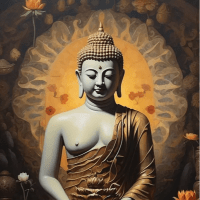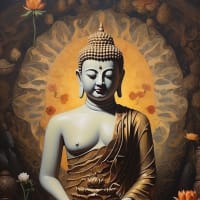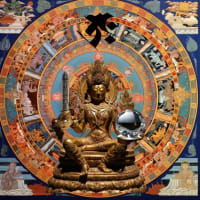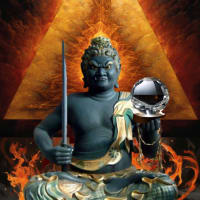◆止(し)と観(かん)


インド仏教の瞑想法の伝統には、シャマタとヴィパシュヤナーの二つがある。それぞれ「止」と「観」と漢訳されている。この二つを合わせて「止観」と称し、体系化されたものとして「天台摩訶止観」が有名であるが、これによりかえって一般には「止観」とは何やらむずかしく、特殊な修行のように思われてしまっているふしがある。だが、南伝仏教でもこの二つの瞑想法(パーリ語では「サマタ」「ヴィパッサナー」という)はきわめてオーソドックスな瞑想法であり、それが今でも修行のアルファでありオメガでもあるといって過言ではない。
シャマタ
シャマタというのは、要するに心を静めることである。この実践は、思念をこらしたり何かに精神集中することではない。ほとんどの仏教辞典にはそう説明されているが、それは正しくない。これは一種の主体の放棄(仏教流にいえば「無我」の実践)ともいうべきもので、具体的にいえば、ただ呼吸を整えるということにつきるのである。
背筋を伸ばし、肩の力を抜き、深い呼吸をこころがける。これ以外に何の特別な努力もしない。これがシャマタの実践である。
ヴィパシュヤナー
それは次のヴィパシュヤナーの実践の不可欠な前提となる
。
ヴィパシュヤナーの原義は「観察」である。何を観察するかというと、仏陀の示した法、すなわち仏法である。たとえば南伝仏教では〈無常〉〈苦〉〈無我〉といった原始仏教以来重視されてきた教理について、これをひとつひとつの事例について観察する。その実践が修行のすべてである。このように仏教の教理というのは無条件に信ずべきドグマなのではなく、すべて瞑想の実践を通して会得すべきものなのである。
大乗仏教になると、ヴィパシュヤナーは、もっぱら〈空〉の会得ということになる。これは「空観」と呼ばれる。
当然、密教でもヴィパシュヤナーを重視する。というより、ヴィパシュヤナーの実践を集大成したのが密教であった。その実践体系は曼荼羅の諸尊に対応するおびただしいヴィパシュヤナーからなるが、とりわけ密教の極位に通達しうる最も簡要な独立した観法として重視されてきたのが阿字観である。
◆阿字観の概略
阿字観とは梵語(サンスクリット語)の阿字を観想する瞑想法である。通常は専用の掛軸の前に座って行なう。
掛軸は紺地。中央に一肘(いっちゅう、肘(ひじ)の長さ分、約一尺)ほどの直径の白円すなわち月輪(がちりん)があり、その中に金色の阿字がおさまっている。これに八葉の蓮華の台座が加わるが、蓮台の上に月輪、その中に阿字がある図柄と、月輪の中に蓮台上の阿字がある図柄との二種がある。それぞれ胎蔵法と金剛法によるといわれるが、後者の図柄のほうが一般的である。

その所作ないし作法には、空海が口述し高弟の実慧が筆録した『阿字観用心口決』や覚鑁の数種の『阿字観』などをはじめ数百種の伝があり、実は一定していない。しかし基本的な次第は通常の密教の行法に準じているので、実修にあたっては正師について指導を受けるのが望ましい。
概略を記すと、
まず口を漱いでから入堂、軸の前に五体投地をして着座。
坐法は結跏趺座または半趺座。
護身法を結印して、発菩提心真言と三昧耶戒真言を誦し、五大願を唱え、大日如来の五字明(真言)を誦したのち、調息してから正観に入る。この部分が阿字観の正行となる(後述)。
手のかたちは法界定印または弥陀定印。終われば出定して、三力加持の偈を唱え、祈願することがあれば念じ、最後に再び五体投地をして出堂。
その際、「心に慈悲の念を抱く」ということが重要である。
伝統的な細かい作法や心得については、直接に伝授を受ける必要がある。ただ、インドの瞑想の伝統では、必ずしも瞑想に時と場所を選ばない。一通りの指導を受けたら、あとは日常の心得として、いつでもどこでも、たとえば電車の中でも実行できる気楽さがあっていい。掛軸がなければ、本物の月に向ってするのも一興である。
◆前提としての月輪観

阿字観は月輪観とセットになっている。阿字のない月輪だけの掛軸もあり、初心者は月輪観だけを行なってもよい。むしろそのほうが好ましく、月輪観に習熟したのち阿字観に進んだほうが効果的である。
簡略な方法としては、目を少し開いて月輪を見る。目を閉じ
て、ゆっくりと月輪を胸中に引き入れる。胸中に月輪が明瞭におさまるようになるまで、これを繰り返す。白浄の満月が自身の内で輝いていると観想して、月輪を再び掛軸に返す。これで完了。
人間の本性とはいかなるものか。善か悪か。意見が分かれるところであるが、仏教では自心の本性は清浄であると説く。これをふまえて、具体的な満月輪をイメージするのが月輪観である。平生の心得としては「いつも心に満月を!」ということになろうか。
月輪観にはこのほか広観と斂観がある。広観とは胸中に引き入れた満月輪を徐々に膨らませていくのである。最初の月の大きさは一肘ほどであるが、自分の体がすっぽりおさまるまでに大きくする。自分がおさまったままで、この月を部屋(道場)の大きさに膨らませ、やがて家を包む大きさに膨らませていき、さらに国土から地球、太陽系、銀河、宇宙の大きさまでスケールを広げていく。
人間の心に果して際限はあるのだろうか。われわれは自分の心をともすれば矮小化し、たえず目先のことに一喜一憂している。ときにはこんな方法で宇宙大の気分を味わってみるのもいいかもしれない。
斂観は広観の逆である。際限なく大きくした月をもとの大きさに戻すのである。
なお順序としては、月輪観に先立って数息観を行なうのが通例である。これは調息の方法であり、ただ息を意識的に数えるだけである。いろいろな数え方があるが、吐く息を一つ、二つと十まで数え、再び一つ、二つと数え、次第に呼吸の間隔を長くしていく。
●阿字観の方法と意義
月輪観に習熟したら、満月輪の中に阿字を置いて観想する阿字観に移る。
これに声と字と実相の三観がある。
ア音はアルファベットの最初の音であるのみならず、梵字のすべては基本的にア音を含むので、原初の音、根源的な音とされる。
そこでまず〈声の阿字観〉だが、出入の息(呼吸)に阿字を観じる。最初は静かにゆっくりと長くア音を発声する。次第に発声を細くしていき、最後は心に念じるようにして行なう。自身より出るア音が自身に満ち、やがて全宇宙に遍満するように観じるのである。
次に〈字の阿字観〉で阿字の形を観じる。要は掛軸の図柄の通りに、満月輪、八葉の蓮華、阿字の三つをしかと心中に映ずるようにする。
最後に〈実相の阿字観〉で阿字の意義を考察する。伝統的には「本不生」の理というが、それはおよそ次のようなことである。
まず先述したように「ア」はすべての言語音の基礎であるから、転じて万物の根源の象徴となる。そこから「本初」を意味する梵語アーディの「ア」であるとみなす。
次に梵語で「ア」は否定辞としても用いられる。否定態として無常、無我、不壊など各種あるが、総じて「不生」を意味する梵語アヌトパーダの「ア」であるとみなす。
仏教では世界の創造を説かない。したがって造物主も認めない。万物は縁によって生じ、縁によって滅す(縁起説)。ものの発生には必ず本がある。いかなるものも無からは生じないのだから、本にもまたその本がある。では原初の本は何か。もちろん誰かが造ったのではない。原初の本が生じたのだとすれば、それはどうして何から生じたのか。
だからそれは「生じた」のではない。だが生じたのでなければ、なぜ諸般のものはある(ようにみえる)のか。結局、生じたとか生じないとかを問えない原初の、思量を越えた事態を「本不生」といい、それを阿字で表して「阿字本不生」というのである。
万物の根源は、万物自体がそこにあるように、やはり宇宙そのものであろう。そして万物の母なる宇宙は、やはり生命を生み育む母のように慈愛に満ちているであろう。
それは現代物理学が描くような暗黒の冷たい物質空間ではない。精神的・霊的存在であるわれわれを生み出した宇宙が、そのようなものであるわけがない。
されば、かくのごとき母なる宇宙を仏とみなして何の不思議もない。さらにそれを最高の尊称として大日如来と呼ぶことも。
かくて阿字は宇宙仏たる大日如来の象徴となる。阿字を観想し、阿字を胸中におさめることは、自身と大日如来との本質的・本源的同一を体感することにほかならない。
注意すべきは、それはエゴの拡大であってはならない。むろん実際には己を虚しうすることなくして実感しえないことであるが。
これをわが身に即していえば、自らの命(魂)の本を考えてみること。誰しも命のふるさとを出でて今生の旅を続け、やがて旅が終われば帰っていく、その本源の場所への思慕。古歌にも、
「阿字の子が阿字のふるさと立ち出でて、また立ち返る阿字のふるさと」とある。
自身の根っこに思いを致すことと言い換えても

◆ Stop and view
There are two Indian Buddhist meditation traditions: Shamata and Vipashyanah. They are translated as "stop" and "kan", respectively. The two are collectively referred to as "Taikan", and the "Tendai Magi-Tankan" is famous as a systematic thing. However, in general, "Tankan" is somewhat difficult and seems to be a special training. There is a mystery that has been broken. However, even in Nanden Buddhism, these two meditation methods (in Pali, called "Samata" and "Vipassana") are extremely orthodox meditation methods, and it is no exaggeration to say that they are still the alpha and OMEGA of training. .
Shamata
Shamata is essentially calming. This practice is not about thinking or focusing on something. That's true in most Buddhist dictionaries, but it's not true. This should be called a kind of abandonment of the subject (a practice of "selfishness" in the Buddhist style), and in concrete terms, it means just breathing.
Stretch your back, relax your shoulders and deep breath. No other special effort is made. This is the practice of Shamata.
Vipashyanah
It is an essential premise for the next Vipashyana practice
.
The original meaning of Vipashyanah is "observation." What to observe is the Buddha's law, the Buddhist law. For example, in Nanden Buddhism, we observe each doctrine of the doctrines that have been emphasized since primitive Buddhism, such as "Permanence", "Bitterness", and "Self". That practice is all about training. In this way, Buddhist doctrines are not unconditionally believed dogmas, but all must be conceived through the practice of meditation.
When it comes to Mahayana Buddhism, Vipashyanah is exclusively about the sky. This is called "Kankan".
Naturally, even in esoteric Buddhism, Vipashyanar is emphasized. Rather, it was esoteric Buddhism that culminated in the practice of Vipashyanah. The practice system consists of numerous Vipashyanahs corresponding to the various mandalas, but the Ajikan has been emphasized as the most simple and independent view that can reach the extreme of esoteric Buddhism.
◆ Overview of Aji
Ajikan is a meditation method of contemplating Aji in Sanskrit. Normally, you sit in front of a dedicated hanging scroll.
The hanging scroll is dark blue. In the center, there is a white circle with a diameter of about one elbow (about the length of an elbow, about one shaku), that is, a moon ring (gachirin), in which a golden A character is placed. A lotus flower pedestal of Yaba is added to this, but there are two types, a moon ring on the lotus stand, a pattern with an A in it, and a pattern with an A on the lotus stand. It is said that they are based on the placental method and Kongo method, respectively, but the latter pattern is more common.
There are hundreds of biographies in the works and manners, including "Ajikanshinkoukoujutsu" written by Kukai and written by Takaki's younger brother, and several "Ajikan" written by Kakuru. Absent. However, since the basic rules are based on the usual esoteric Buddhist law, it is desirable to receive guidance from an orthodox teacher when practicing.
In summary,
First, scoop out your mouth, then enter the hall.
The seating method is either Yagi or Semi-Legit.
After signing the Self-Defense Law, he recites the Bodhisattva Shingon and the Sanmai Yakai Shingon, chants the Five Great Wishes, and recites the Dainichi Nyorai's Five Characters (Shingon). This part is the correct line for Ajikan (described later).
The shape of the hand is the Hokai seal or the Mida seal. When it's over, I'll make a decision, recite the power of three strengths, and if there's a prayer, I will pray, and finally I will throw five bodies again and go out.
At that time, it is important to "have compassion for the heart."
You will need to be directly informed about the traditional fine manners and knowledge. However, the Indian meditation tradition does not always choose time and place for meditation. Once you have received all the instructions, you should have the comfort of being able to carry it out anytime, anywhere, for example on the train, as a daily routine. If you don't have a hanging scroll, it would be fun to go to the real moon.
◆ View of moon ring as a premise
The view of Aji is set with the view of the moon ring. There is also a hanging scroll with only the moon ring without a letter, so beginners may only watch the moon ring. Rather, that is preferable, and it is more effective to proceed to Aji after learning the moon ring.
A simple way is to open your eyes and look at the moon ring. Close your eyes
Then slowly pull the moon ring into your chest. Repeat until the moon ring is clearly set in your chest. Thinking that the white moon of Shirajo is shining in herself, she returns the moon ring to the hanging scroll again. You're done.
What is human nature? Good or bad? Although opinions are divided, Buddhism says that the true nature of one's mind is clean. Based on this, the image of a concrete full moon is the image of the moon ring. I wonder if Hirai's knowledge is to always have a full moon in my heart!
In addition to the view of the moon ring, there is a wide view and a new view. The wide view is to gradually inflate the full moon ring drawn into the chest. The size of the first moon is about one elbow, but make it big enough to fit your body. As I settle down, I expand this moon to the size of a room (dojo) and eventually to the size of a house, and further expand the scale from the land to the size of the earth, solar system, galaxies, and the universe.
Is there a limit to the human mind? We are dwarfed with our own hearts, and we are constantly delighted with the immediate future. It might be good to try the feeling of space universe in this way.
The perspective is the opposite of the perspective. The endlessly enlarged moon is restored to its original size.
In addition, as a sequence, it is customary to perform a number of breathing views prior to the moon ring. This is a way of breathing, it only counts breaths consciously. There are various methods of counting, but the number of breaths to be exhaled is counted to one, two and ten, and again to be one and two, and the interval between breaths is gradually lengthened.
● Aji's method and significance
Once you have become accustomed to the moon ring view, place the A character inside the full moon ring and move on to the A character view.
There are three views: voice, letters, and reality.
The A sound is not only the first sound in the alphabet, but all the Sanskrit characters basically include the A sound, so it is regarded as the original sound and the fundamental sound.
So, first of all, I would like to look at Aji in the voice. At first, she utters quietly, slowly and long. Gradually reduce the vocalization, and at the end, keep in mind. The sound that comes out of himself fills himself, and eventually he permeates the entire universe.
Next, look at the shape of Aji with <view of Aji of character>. The point is that you can see the full moon ring, the lotus flower of Yaba, and the three letters of A in the heart.
Finally, we will examine the meaning of Aji in <Actual view of Aji>. Traditionally, the theory of "book immortality" is as follows.
First of all, as mentioned above, "A" is the basis of all speech sounds, so it becomes a symbol of the root of all things. From there, it is considered to be the "A" in the Sanskrit word "Ardi".
Next, in the Sanskrit, "a" is also used as a negation. There are various types of denial, such as permanent, selfless, and unbreakable, but they are generally regarded as the "A" in the Sanskrit Anutupada, which means "immortality."
Buddhism does not preach the creation of the world. Therefore, the creator cannot accept it. All things are created by the edge and destroyed by the edge (Lingus theory). Every occurrence has a book. A book also has a book, because nothing comes from nothing. Then what is the original book? Of course someone didn't. If the original book came about, why did it come from?
So it wasn't "caused." But if they haven't occurred, why are there so many things? In the end, the original, beyond-thinking situation, which can be asked whether it has occurred or not, is called "honsei", and it is expressed in A and is called "Ajihonsei."
The origin of all things will be the universe itself, just as all things are there. And the mother universe of all things will be full of compassion like the mother of life.
It is not the dark cold material space that modern physics depicts. The universe that created us as spiritual and spiritual beings cannot be like that.
If so, it is no wonder that Mother Universe is a Buddha. Furthermore, it may be called Dainichi Nyorai as the highest honorific name.
Thus, Aji becomes a symbol of Dainichi Nyorai, the universe Buddha. To think about Aji and keep it in my heart is nothing but to experience the essential and essential identity between myself and Dainichi Nyorai.
Note that it should not be an ego expansion. Of course, the fact is that you can't realize it without deceiting yourself.
If this is adapted to us, consider the book of our own life (soul). Everybody leaves the hometown of life and continues the journey of this life, and when the journey ends, he returns, a longing for the place of its origin. For old songs,
"The child of Aji stands out from the hometown of Aji and returns to the hometown of Aji."
In other words, to think of your roots

























※コメント投稿者のブログIDはブログ作成者のみに通知されます